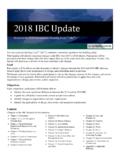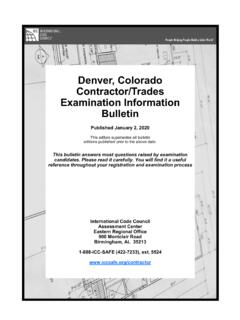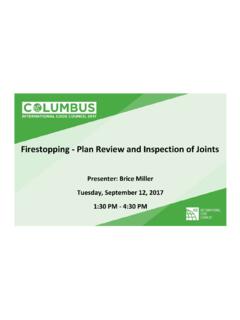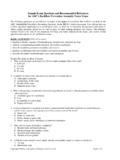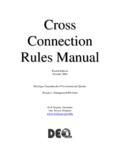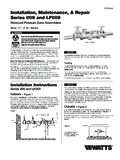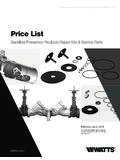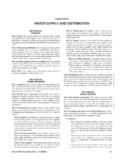Transcription of Backflow Preventers and Protection of Water Supply: 2015 IPC
1 1 IntroductionProtection of the Water supply used for drinking, cooking, washing and bathing is one of the most important health and safety Protection requirements of the plumbing code. History has many examples of local and widespread occurrences of sickness and disease caused by not safeguarding the Water supply. Cross-connections are the links through which it is possible for contamination to enter a potable Water supply. The contaminant enters the potable Water supply when the pressure of the polluted source exceeds the pressure of the potable source. The action may be called backsiphonage or backpressure. The intent of the plumbing code is to eliminate cross-connections or prevent Backflow where cross-connections cannot be provides cross-connection scenarios and Backflow prevention methods and devices in an organized and user-friendly approach in accordance with the requirements of the 2015 International Plumbing Code (IPC ) and International Residential Code (IRC ).
2 It covers: Cross connection potential and where Backflow Protection is required. Backflow prevention devices, methods and installation limitations. Other Backflow prevention related Connection Potential and Where Backflow Protection is RequiredThe following are situations where there is potential for Backflow to occur: Irrigation systems ( Backflow of irrigation Water into the potable Water system through the sprinkler and emitter and leaks in the irrigation piping); see Figure 1. Sillcocks, hose bibbs, wall hydrants and other openings with a hose connection ( Backflow of insanitary Water or liquid through the open end of the hose).
3 Toilet tanks (unapproved tank fill valves). Sinks and lavatories (unapproved air gap). Coffee machines directly connected to the Water supply ( Backflow of coffee into Water supply). Soft drink dispensing machines ( Backflow of carbon dioxide gas (CO2) into copper Water supply line).CodeNotes Backflow Preventers and Protection of Water Supply: 2015 IPC and IRC CodeNotes is provided courtesy of the ICC PMG Official Membership CouncilFigure 1 Lawn Irrigation2 The potable Water supply connection to an irrigation system must be protected from contamination by installing an approved/listed Backflow prevention device. Atmospheric vacuum breakers (AVB), a pressure vacuum breaker (PVB), a spill resistant pressure vacuum breaker (SVB) or a reduced pressure principle Backflow preventer (RP) are acceptable assemblies.
4 (See Table of the 2015 editions of the IPC or Table of the 2015 editions of the IRC, depending on the code that is applicable in your area).In all buildings with two or more Water distribution systems, one potable and the other nonpotable, each system must be identified either by color marking or metal tags. The color must be consistent throughout the building and the size (see Sections of the 2015 editions of the IPC and of the 2015 editions of the IRC; also see Figure 2). Reduced Pressure Principle Assemblies Provide Protection against low hazard (pollution) or high hazard (contaminate). Provide Protection against backsiphonage and backpressure Backflow .
5 The assembly can be used where it is under continuous pressure from the Water supply. The relief valve opening must discharge through an air gap. The assembly must be accessible for testing and maintenance. The assembly cannot be installed below grade where it may be subject to submersion. Provisions must be made at or near the location of the installation to prevent drainage from the relief valve opening causing damage to the structure when the device is installed in a building or structure. Pressure Vacuum Breakers Provide Protection against low hazard (pollutant) or high hazard (Contaminate). Provide Protection against backsiphonage only.
6 Can be used where it is under continuous pressure from the Water supply (valving permitted downstream). This assembly has a critical level of installation of 6 inches (152 mm) above the flood level rim. The assembly must be accessible for field testing and maintenance. Provisions must be made at or near the location of the installation to prevent drainage from the air inlet opening causing damage to the surrounding area when the assembly is installed in a building or Vacuum Breakers Provide Protection against low hazard (pollution) or high-hazard (contaminate). Provide Protection against backsiphonage only. The device cannot be installed where it is under continuous pressure from the Water supply (12-hour or less intervals).
7 The assembly must be accessible for field inspection and 2 Cross Connections3 Double Check Backflow Prevention Assemblies These assemblies are designed for low hazard (pollutant) applications subject to backpressure and backsiphonage. The assembly must be accessible for field testing and maintenance. These assemblies must not be confused with dual check-valve devices or two single check valves placed in sprinkler systems may use a double check detector assembly to prevent Backflow and detect unauthorized use of Gap Piping System The most effective and dependable means of preventing Backflow and should be used where feasible.
8 The minimum required air gap must be measured from the lowest end of a potable Water outlet to the flood level rim of the fixture or receptacle into which such potable Water outlet discharges. Air gaps must comply with Table of the IPC or of the IRC. The distance between the outlet and a wall or similar obstruction (see Table of the IPC or of the IRC).Air Gap = 2 x the diameter of the effective opening(Effective Openings greater than one inch)CRITICAL DEFINITIONSPOLLUTION. An impairment of the quality of the potable Water to a degree that does not create a hazard to the public health but that does adversely and unreasonably affect the aesthetic qualities of such potable Water for domestic An impairment of the quality of the potable Water that creates an actual hazard to the public health through poisoning or through the spread of disease by sewage, industrial fluids or and Testing of BackflowBackflow prevention assemblies are critical components that protect the potable Water systems from pollution or contamination sources.
9 The IPC and IRC require annual inspections be made of all Backflow prevention assembles to determine whether they are operable. The air gap like Backflow prevention assemblies are critical and must be inspected to determine that proper clearances have been provided. The IPC takes it a step further and requires that inspection of air gaps be part of the annual inspection. Section of the IPC requires that the test procedure for reduced pressure principle, double check, pressure vacuum, reduced pressure detector fire Protection , and spill-resistant vacuum breaker Backflow preventer assemblies and hose connection Backflow Preventers be performed in accordance with one of the following standards: ASSE 5013, ASSE 5015, ASSE 5020, ASSE5047, ASSE 5048, ASSE 5052, ASSE 5056, CSA or is an excerpt from the 2015 IPC Code and Commentary.
10 For more information on this publication, visit Backflow Prevention Related Information Access must be provided to Backflow Preventers as specified by the installation instructions of the approved manufacturer (see Sections of the IPC and of the IRC). Water pumps, filters, softeners, tanks and all other devices that handle or treat potable Water must be protected against contamination (see Section ). Proper identification of potable and nonpotable Water systems (see Section ).For Water closet Backflow assembly , see Figure of the 2015 IPC and of the 2015 IRC require that the color purple be used to identify reclaimed, rain, and gray Water distribution systems (see Figure 8).
